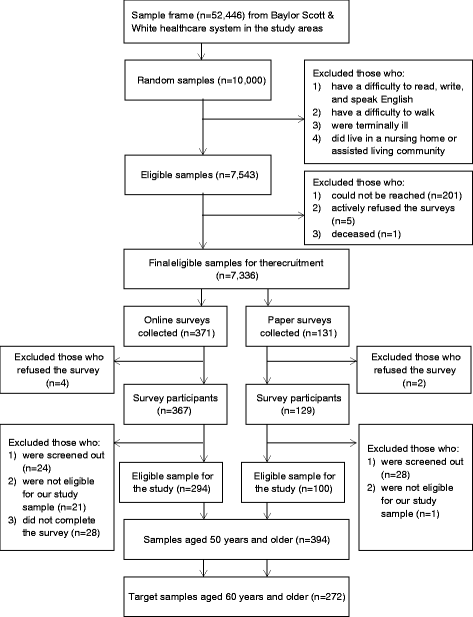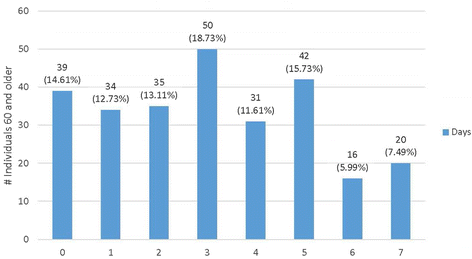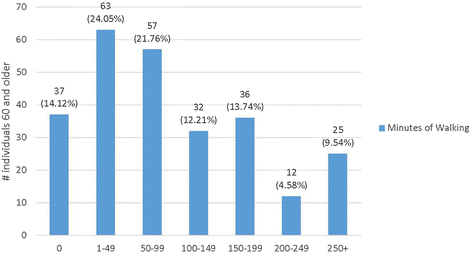Social and environmental predictors of walking among older adults
- PMID: 27553668
- PMCID: PMC4995768
- DOI: 10.1186/s12877-016-0327-x
Social and environmental predictors of walking among older adults
Abstract
Background: Regular physical activity (PA) is a major factor in maintaining health in aging populations. This study examines the influences of sociodemographic, health, and environmental characteristics on older adults' walking behaviors, and the role physicians can play in promoting physical activity.
Methods: Online and paper surveys (n = 272) were distributed to community-dwelling older (age ≥ 60) adults from a large integrated healthcare system in two counties in Central Texas. Descriptive statistics were utilized to characterize participant's walking behaviors and places. Multivariate logistic regression was employed to predict being: 1) a frequent walker (i.e., walking at least three times a week); and 2) meeting the Centers for Disease Control and Prevention (CDC) PA recommendation through walking (i.e., walking ≥150 min per week), while considering sociodemographic, health, and environmental factors.
Results: Individuals had a median age of 69 years, were of both genders (50.37 % female), and were primarily non-Hispanic White (84.87 %). While the majority (59.55 %) walked at least three times a week, only 27.86 % walked ≥150 min a week. Factors associated with a lower likelihood of being frequent walkers included experiencing poor mental health in the past month (OR = 0.345, 95 % CI = 0.185-0.645) and residing in areas with low or moderate (versus high) perceived neighborhood cohesion (OR = 0.471, 95 % CI = 0.228-0.974), while those in Census Tracts reflecting populations with a lower median age were more likely to report frequent walking behavior (OR = 1.799, 95 % CI = 1.034-3.131). Factors associated with a lower likelihood of meeting the CDC PA recommendation included being 60-69 years (versus 70 years or older) (OR = 0.538, 95 % CI = 0.290-0.997), experiencing poor mental health in the past month (OR = 0.432, 95 % CI = 0.198-0.944), and lacking social support for walking (OR = 0.383, 95 % CI = 0.154-0.957).
Conclusion: Given the health benefits, PA promotion must be seen as a national responsibility. In particular, physicians have a major role to play in communicating the importance of PA to their older patients and making discussions about strategies for overcoming barriers to walking an integral part of their clinical encounter with these patients.
Keywords: Health and place; Healthy aging; Older adults; Physical activity; Social environment; Walking.
Figures
Similar articles
-
Community Environments That Promote Intergenerational Interactions vs. Walking Among Older Adults.Front Public Health. 2020 Dec 3;8:587363. doi: 10.3389/fpubh.2020.587363. eCollection 2020. Front Public Health. 2020. PMID: 33344399 Free PMC article.
-
The Association between Belgian Older Adults' Physical Functioning and Physical Activity: What Is the Moderating Role of the Physical Environment?PLoS One. 2016 Feb 12;11(2):e0148398. doi: 10.1371/journal.pone.0148398. eCollection 2016. PLoS One. 2016. PMID: 26872017 Free PMC article.
-
Fear of Outdoor Falling Among Community-Dwelling Middle-Aged and Older Adults: The Role of Neighborhood Environments.Gerontologist. 2018 Nov 3;58(6):1065-1074. doi: 10.1093/geront/gnx123. Gerontologist. 2018. PMID: 28958081
-
Exercise-Based Interventions to Enhance Long-Term Sustainability of Physical Activity in Older Adults: A Systematic Review and Meta-Analysis of Randomized Clinical Trials.Int J Environ Res Public Health. 2019 Jul 15;16(14):2527. doi: 10.3390/ijerph16142527. Int J Environ Res Public Health. 2019. PMID: 31311165 Free PMC article.
-
Effectiveness of pedometer-based walking programmes in improving some modifiable risk factors of stroke among community-dwelling older adults: a systematic review, theoretical synthesis and meta-analysis.BMC Geriatr. 2024 Jun 13;24(1):516. doi: 10.1186/s12877-024-05069-z. BMC Geriatr. 2024. PMID: 38872081 Free PMC article.
Cited by
-
Muscle synergies and metabolic adaptations during perturbed walking in older adults.Sci Rep. 2025 Jul 2;15(1):23597. doi: 10.1038/s41598-025-07835-4. Sci Rep. 2025. PMID: 40603515 Free PMC article.
-
Community Environments That Promote Intergenerational Interactions vs. Walking Among Older Adults.Front Public Health. 2020 Dec 3;8:587363. doi: 10.3389/fpubh.2020.587363. eCollection 2020. Front Public Health. 2020. PMID: 33344399 Free PMC article.
-
Association of the built environments and health-related quality of life in community-dwelling older adults: a cross-sectional study.Qual Life Res. 2019 Sep;28(9):2393-2407. doi: 10.1007/s11136-019-02199-5. Epub 2019 May 9. Qual Life Res. 2019. PMID: 31073818
-
A Grounded Theory of Walking for Health Promotion in Older Urban Adults.Gerontologist. 2024 Oct 1;64(10):gnae091. doi: 10.1093/geront/gnae091. Gerontologist. 2024. PMID: 39039921 Free PMC article.
-
Neighborhood built and social environment and meeting physical activity recommendations among mid to older adults with joint pain.Prev Med Rep. 2020 Feb 11;18:101063. doi: 10.1016/j.pmedr.2020.101063. eCollection 2020 Jun. Prev Med Rep. 2020. PMID: 32140385 Free PMC article.
References
-
- US Dept of Health Human Services . 2008 physical activity guidelines for Americans. Washington, DC: US Dept of Health and Human Services; 2008.
-
- Chodzko-Zajko W. ACSM’s exercise for older adults: Lippincott Williams & Wilkins. 2013.
-
- Towne SD Jr, Won J, Lee S, Ory MG, Forjuoh SN, Wang S, Lee C. Using Walk Score™ and Neighborhood Perceptions to Assess Walking Among Middle-Aged and Older Adults. J Community Health. 2016 Mar 19. [Epub ahead of print] PubMed PMID: 26994989. - PubMed
-
- Towne SD Jr., Smith ML. PJ, Lee C., Ory MG. Chapter 8: Older Adults. In: Bolin JN BG, Ferdinand AO, Kash BA, Helduser JW, editor. Rural Health People 2020: A Companion Document to Healthy People 2020. 1: Southwest Rural Health Research Center, School of Public Health, Texas A&M University System Health Science Center; 2014.
MeSH terms
LinkOut - more resources
Full Text Sources
Other Literature Sources
Medical
Miscellaneous




